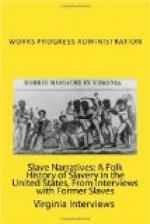While this old Negro may be mistaken at some points (the universal failing of witnesses), his impressions are certainly not more involved than the welter of local records. Mrs. Currie states that if Sam said he saw a thing happen thus, it may be depended upon that he is telling exactly what he really saw.
Sam McAllum, ex-slave, lives in Meridian, Lauderdale County. Sam is five feet three inches tall and weighs 140 pounds.
“De firs’ town I ever seen were DeKalb in Kemper County. De Stephenson Plantation where I were born warnt but ‘bout thirteen miles north o’ DeKalb. I were born de secon’ o’ September in 1842. My mammy b’longed to de Stephensons an’ my pappy b’longed to Marster Lewis Barnes. His plantation wasn’t so very far from Stephenson. De Stephensons an’ Barneses were kin’ white people. My pappy were a old man when I were born—I were de baby chil’. After he died, my mammy marry a McAllum Nigger.
“Dey were ’bout thirty slaves at Stephenson. My mammy worked in de fiel’, an’ her mammy, Lillie, were de yard-woman. She looked after de little cullud chillun.
“I don’t recollec’ any playthings us had ’cept a ball my young marster gimme. He were Sam Lewis Stephenson, ’bout my age. De little cullud chillun’ ud play ‘Blin’ Man’, ‘Hidin’’, an’ jus’ whatever come to han’.
“My young marster learned me out o’ his speller, but Mistis whupped me. She say I didn’ need to learn nothin’ ’cept how to count so’s I could feed de mules widout colicin’ ’em. You give’ em ten years[FN: ears] o’ corn to de mule. If you give’ em more, it ‘ud colic’ ’em an’ dey’d die. Dey cos’ more’n a Nigger would. Dat were de firs’ whuppin’ I ever got—when me an’ my young marster were a-spellin’.
“I stayed wid him special, but I waited on all de white folk’s chillun at Stephenson. I carried de foot tub in at night an’ washed dey foots, an’ I’d pull de trun’le bed out from under de other bed. All de boys slep’ in de same room.
“Den I were a yard boy an’ waited on de young marster an’ mistis. Hadn’ been to de fiel’ den—hadn’ worked yet.
“Mr. Stephenson were a surveyor an’ he fell out wid Mr. McAllum an’ had a lawsuit. He had to pay it in darkies. Mr. McAllum had de privilege o’ takin’ me an’ my mammy, or another woman an’ her two. He took us. So us come to de McAllum plantation to live. It were in Kemper, too, ’bout eight miles from Stephenson. Us come dere endurin’ of de war. Dat were when my mammy marry one of de McAllum Niggers. My new pappy went to de war wid Mr. McAllum an’ were wid ’im when he were wounded at Mamassas Gab Battle. He brung ‘im home to die—an’ he done it.
“Den de Yankees come th’ough DeKalb huntin’ up cannons an’ guns an’ mules. Dey sho’ did eat a heap. Us hid all de bes’ things lak silver, an’ driv’[FN: drove] de stock to de swamp. Dey didn’ burn nothin’, but us hear’d tell o’ burnin’s in Scooba an’ Meridian. I were a-plowin’ a mule an’ de Yankees made me take him out. De las’ I seen o’ dat mule, he were headed for Scooba wid three Yankees a-straddle of ’im.




